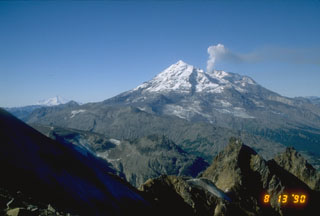Report on Redoubt (United States) — January 1991
Bulletin of the Global Volcanism Network, vol. 16, no. 1 (January 1991)
Managing Editor: Lindsay McClelland.
Redoubt (United States) Minor ash emission from dome; continued seismicity; SO2 data
Please cite this report as:
Global Volcanism Program, 1991. Report on Redoubt (United States) (McClelland, L., ed.). Bulletin of the Global Volcanism Network, 16:1. Smithsonian Institution. https://doi.org/10.5479/si.GVP.BGVN199101-313030
Redoubt
United States
60.485°N, 152.742°W; summit elev. 3108 m
All times are local (unless otherwise noted)
The following summarizes 10 January to 7 February 1991. "Seismicity at Redoubt continued at roughly the same rate that has characterized activity since mid-1990. The occurrence of long, low-frequency signals associated with 'steam and gas emissions' has decreased to an approximate rate of 1-2/week. Shallow, long-period events beneath the lava dome and volcano-tectonic earthquakes 5-9 km below the volcano continue to occur. A slight increase in shallow, high-frequency earthquakes, possibly associated with adjustment of the lava dome, was noticed about 29 January.
"COSPEC measurements of SO2 emission rates at Redoubt were attempted on 23 January. Low ultraviolet levels in the winter sky combined with relatively low SO2 resulted in a high signal to noise ratio, but an average emission rate of about 300 t/d was calculated for two of the five orbits. This value is at the low end of the range of emission rates measured since March 1990. The last COSPEC result, approximately 570 t/d, had been obtained on 8 November.
"The lava dome appeared unchanged since the last report period, and it was heavily mantled with snow. Fumarolic activity remains vigorous, especially on the S and W sides. A minor amount of ash was occasionally visible on the dome and crater walls."
Geological Summary. Redoubt is a glacier-covered stratovolcano with a breached summit crater in Lake Clark National Park about 170 km SW of Anchorage. Next to Mount Spurr, Redoubt has been the most active Holocene volcano in the upper Cook Inlet. The volcano was constructed beginning about 890,000 years ago over Mesozoic granitic rocks of the Alaska-Aleutian Range batholith. Collapse of the summit 13,000-10,500 years ago produced a major debris avalanche that reached Cook Inlet. Holocene activity has included the emplacement of a large debris avalanche and clay-rich lahars that dammed Lake Crescent on the south side and reached Cook Inlet about 3,500 years ago. Eruptions during the past few centuries have affected only the Drift River drainage on the north. Historical eruptions have originated from a vent at the north end of the 1.8-km-wide breached summit crater. The 1989-90 eruption had severe economic impact on the Cook Inlet region and affected air traffic far beyond the volcano.
Information Contacts: AVO Staff.

